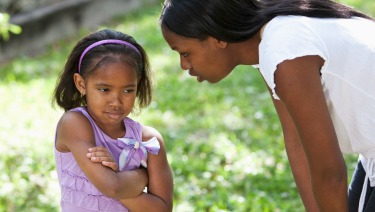10 Ways to Discipline Your Child Funny
Family Life
What's the Best Way to Discipline My Child?


Page Content
As a parent, one of your jobs to teach your child to behave. It's a job that takes time and patience. But, it helps to learn the effective and healthy discipline strategies.
Here are some tips from the American Academy of Pediatrics (AAP) on the best ways to help your child learn acceptable behavior as they grow.
10 Healthy Discipline Strategies That Work
The AAP recommends positive discipline strategies that effectively teach children to manage their behavior and keep them from harm while promoting healthy development. These include:
-
Show and tell. Teach children right from wrong with calm words and actions. Model behaviors you would like to see in your children.
-
Set limits. Have clear and consistent rules your children can follow. Be sure to explain these rules in age-appropriate terms they can understand.
-
Give consequences. Calmly and firmly explain the consequences if they don't behave. For example, tell her that if she does not pick up her toys, you will put them away for the rest of the day. Be prepared to follow through right away. Don't give in by giving them back after a few minutes. But remember, never take away something your child truly needs, such as a meal.
-
Hear them out. Listening is important. Let your child finish the story before helping solve the problem. Watch for times when misbehavior has a pattern, like if your child is feeling jealous. Talk with your child about this rather than just giving consequences.
-
Give them your attention. The most powerful tool for effective discipline is attention—to reinforce good behaviors and discourage others. Remember, all children want their parent's attention.
-
Catch them being good. Children need to know when they do something bad--and when they do something good. Notice good behavior and point it out, praising success and good tries. Be specific (for example, "Wow, you did a good job putting that toy away!").
-
Know when not to respond. As long as your child isn't doing something dangerous and gets plenty of attention for good behavior, ignoring bad behavior can be an effective way of stopping it. Ignoring bad behavior can also teach children natural consequences of their actions. For example, if your child keeps dropping her cookies on purpose, she will soon have no more cookies left to eat. If she throws and breaks her toy, she will not be able to play with it. It will not be long before she learns not to drop her cookies and to play carefully with her toys.
-
Be prepared for trouble. Plan ahead for situations when your child might have trouble behaving. Prepare them for upcoming activities and how you want them to behave.
-
Redirect bad behavior. Sometimes children misbehave because they are bored or don't know any better. Find something else for your child to do.
-
Call a time-out. A time-out can be especially useful when a specific rule is broken. This discipline tool works best by warning children they will get a time out if they don't stop, reminding them what they did wrong in as few words―and with as little emotion―as possible, and removing them from the situation for a pre-set length of time (1 minute per year of age is a good rule of thumb). With children who are at least 3 years old, you can try letting their children lead their own time-out instead of setting a timer. You can just say, "Go to time out and come back when you feel ready and in control." This strategy, which can help the child learn and practice self-management skills, also works well for older children and teens.
Spanking and Harsh Words are Harmful and Don't Work. Here's Why: |
|---|
Learn from Mistakes—Including Your Own
Remember that, as a parent, you can give yourself a time out if you feel out of control. Just make sure your child is in a safe place, and then give yourself a few minutes to take a few deep breaths, relax or call a friend. When you are feeling better, go back to your child, hug each other, and start over.
If you do not handle a situation well the first time, try not to worry about it. Think about what you could have done differently and try to do it the next time. If you feel you have made a real mistake in the heat of the moment, wait to cool down, apologize to your child, and explain how you will handle the situation in the future. Be sure to keep your promise. This gives your child a good model of how to recover from mistakes.
Healthy & Effective Discipline Tips by Age/Stage
Infants |
|
|---|---|
Toddlers |
|
Preschool Age |
|
Gradeschool-Age Children |
|
Adolescents & Teens |
|
Additional Information:
- 15 Tips to Survive the Terrible 3's
-
How to Shape and Manage Your Young Child's Behavior
-
Disciplining Older Children
-
How to Give a Time-Out
-
Effective Discipline to Raise Healthy Children (AAP Policy Statement)
Article Body
- Last Updated
- 11/5/2018
- Source
- American Academy of Pediatrics (Copyright © 2018)
The information contained on this Web site should not be used as a substitute for the medical care and advice of your pediatrician. There may be variations in treatment that your pediatrician may recommend based on individual facts and circumstances.
beltranplancionsing.blogspot.com
Source: https://www.healthychildren.org/English/family-life/family-dynamics/communication-discipline/Pages/Disciplining-Your-Child.aspx
0 Response to "10 Ways to Discipline Your Child Funny"
Post a Comment